
Original Link: https://www.anandtech.com/show/2037
ASUS M2N32-SLI & Epox MF570SLI: AM2 Wunderkinder
by Wesley Fink on June 28, 2006 5:10 AM EST- Posted in
- Motherboards
For a platform and CPU that were almost invisible before their May 23rd launch, AM2 and the supporting AM2 chipsets are proving to be remarkably mature. Part 1 and Part 2 of our AM2 roundup examined four AM2 motherboards based on the nForce 500 family of chipsets. Three were based on the top-end 590 SLI chipset and one was based on the mainstream 570 SLI chipset. Part 3 looks at two of the most exciting nForce 500 motherboards that have been evaluated - the readily available top-end ASUS M2N32-SLI Deluxe and the mainstream Epox MF570SLI.
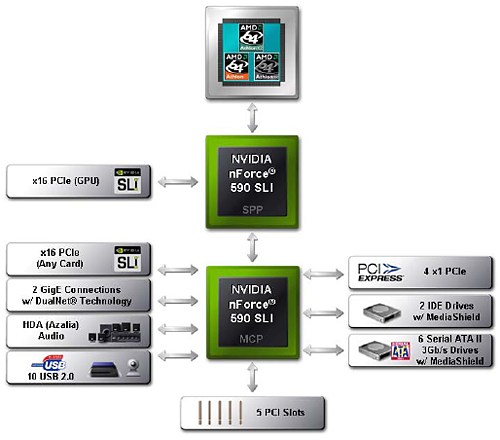
The ASUS M2N32-SLI was quickly out the door as the Reference Board supplied by AMD for the AM2 launch. CPU manufacturers are always careful about Reference Boards and AMD's confidence in the ASUS AM2 platform speaks highly of the board's stability and performance. Our review here is based on the full retail version of the M2N32-SLI Deluxe, complete with on-board wireless 802.11 b/g and dual-Gigabit LAN ports that can be "teamed" to create a 2Gb port. The review board is currently available at many on-line e-tailers and local computer shops. For more information on pricing and availability of the M2N32-SLI Deluxe please refer to the just-published Price Guide, June 2006: Motherboards

Just below the nForce 590 for AM2 is the single X16/dual X8 nForce 570 SLI. The 570 SLI uses the same new 590 chip as the top-end chipset, but it does not supply the second SPP chip for the additional X16 PCIe support.
| nForce 500 Specifications | ||||
| NVIDIA nForce 590 SLI |
NVIDIA nForce 570 SLI |
NVIDIA nForce 570 Ultra |
NVIDIA nForce 550 | |
| Segment | Enthusiast SLI (2 X16) |
Performance SLI (2 X8) |
Performance | Mainstream |
| CPU Suggestion | Athlon 64 FX Athlon 64 X2 Athlon 64 |
Athlon 64 FX Athlon 64 X2 Athlon 64 |
Athlon 64 FX Athlon 64 X2 Athlon 64 |
Athlon 64 Sempron |
| SLI Technology | Yes | Yes | No | No |
| NVIDIA LinkBoost | Yes | No | No | No |
| NVIDIA FirstPacket | Yes | Yes | Yes | No |
| NVIDIA DualNet | Yes | Yes | Yes | No |
| Gigabit Connections | 2 | 2 | 2 | 1 |
| Teaming | Yes | Yes | Yes | No |
| TCP/IP Acceleration | Yes | Yes | Yes | No |
| MediaShield | Yes | Yes | Yes | Yes |
| SATA / PATA Drives | 6 SATA 2 PATA |
6 SATA 2 PATA |
6 SATA 2 PATA |
4 SATA 2 PATA |
| RAID | 0, 1, 0+1, 5 | 0, 1, 0+1, 5 | 0, 1, 0+1, 5 | 0, 1, 0+1 |
| NVIDIA nTune 5 | Yes | Yes | Yes | Yes |
| PCI Express Lanes | 46 | 28 | 20 | 20 |
| Links | 9 | 6 | 5 | 5 |
| USB Ports | 10 | 10 | 10 | 10 |
| PCI Slots Supported | 5 | 5 | 5 | 5 |
| Audio | Azalia | Azalia | Azalia | Azalia |
570 SLI also does not support all the NVIDIA auto-overclocking features like LinkBoost as you can see in the above chart. 570 is clearly a mainstream part, but performance should be at the same level as nForce 590. The most important distinction is support for dual X16 PCIe on 590 versus support for dual X8 PCIe on 570 SLI. For more information and a detailed comparison of the nForce 500 family chipsets please refer to nForce 500: nForce4 on Steroids?
The Epox MF570SLI is based on this mainstream 570 SLI chipset. You will see in the review of this board that you can still find an incredibly well-appointed board with almost every overclocking option you can imagine in a mainstream-priced board.
ASUS M2N32-SLI Deluxe: Basic Features & Board Layout
| ASUS M2N32-SLI Deluxe | |
| CPU Interface | Socket AM2 |
| Chipset | NVIDIA 590 SLI MCP (ID0360) + NVIDIA 590 SLI SPP (C51-GeForce 6100/6150) |
| Bus Speeds | 200 to 425 in 1MHz Increments |
| Memory Speeds | DDR2 at Auto, 400, 533, 667, 800 |
| PCIe Speeds | 100 to 200 in 1MHz Increments (Separate Adjustments for each X16 PCIe slot) |
| AI Tuning | Manual, Auto, Standard, AI Overclock, AI N.O.S. |
| Core Voltage | Auto, 0.8V to 1.5625V in 0.0025V increments PLUS 0.2V CPU Offset (Max 1.8625V) |
| PEG Link Mode | Auto, Disabled, Normal, Fast, Faster |
| CPU Clock Multiplier | Auto, 4x-25x in 1X increments |
| DRAM Voltage | 1.8V to 2.5V in .025v increments |
| DDR2 Termination Voltage | 1.5v, 1.6v |
| 1T/2T Memory | Auto, 1T, 2T |
| AI Clock Skew | Auto, Manual |
| Manual Clock Skew | Normal, Advance or Delay 150, 300, 450, 600, 750, 900ps for EACH Channel |
| Advanced Memory Timings | 23 Options |
| DRAM Timing Control | 10 Options |
| Output Driver Control | 7 Options |
| SLI Ready Memory | Disabled, Optimal, High Performance, High Frequency |
| HyperTransport Frequency | 1000MHz (1GHz) (Stable in overclocking to 1500+ HT) |
| HyperTransport Multiplier | Auto, 1X to 5X |
| NB to SB HT | Auto, 200 to 400 in 1MHz increments |
| CPU to NB HT | Auto, 1X to 5X CPU Frequency |
| NB to SB HT | 1x to 5x NB to SB Frequency |
| SB to NB HT | 1x to 5x SB to NB Frequency |
| CPU to NB HT Width | 8up/down, 16up/down |
| NB to SB HT Width | 4up/down, 8up/down, 16up/down |
| NVIDIA GPU EX | Auto, Disabled |
| CPU to NB Voltage | Auto, 1.200v to 1.500v in 0.025v increments |
| NB to SB Voltage | Auto, 1.300v to 1.500v in 0.025v increments |
| NB Core/PCIe Voltage | Auto, 1.200v to 1.400v in 0.05v increments |
| SB Core/PCIe Voltage | Auto, 1.200v to 1.400v in 0.05v increments |
| SB Standby Voltage | 1.5v, 1.6v, 1.7v |
| AMD Live! | Disabled, Enabled |
| AMD Cool'n'Quiet | Disabled, Enabled |
| Memory Slots | Four 240-pin DDR2 DIMM Slots Dual-Channel Configuration Regular Unbuffered ECC/non ECC Memory to 16GB Total |
| Expansion Slots | 2 PCIe X16 1 PCIe X4 3 PCI Slots |
| Onboard SATA/RAID | 6 SATA2 Drives by MCP (RAID 0, 1, 1+0, 10, JBOD) PLUS 2 SATA2 Drives by Silicon Image 3132 (RAID 0, 1) (1 internal, 1 external) |
| Onboard IDE/IDE RAID | One Standard ATA133/100/66 (2 drives) |
| Onboard USB 2.0/IEEE-1394 | 10 USB 2.0 ports supported by MCP 590 2 Firewire 1394a by TI |
| Onboard LAN | DUAL PCIe Gigabit by Marvel PHY for AI Net2 PLUS WiFi 802.11b/g by Realtek RTL8187L |
| Onboard Audio | Azalia HD Audio by Soundmax ADI AD1988B 8 channel codec |
| BIOS Revision | Award 504 - June 14, 2006 |
Current thinking in overclocking options is to provide very fine adjustments for voltages over a very wide range of control. ASUS certainly meets these expectations in the BIOS options for their new AM2 board. Memory voltage extends from 1.8V to 2.5V, but just as important is the very fine granularity of .025V increments. This provides very fine tweaking of the voltage to get the most from the memory with the least prospect for memory damage.
Similar attention to detail is evident throughout the BIOS options and feature set. Adjustable voltages are provided for just about any chip and any HT link available on the board. CPU range is 200 to 425, and each PCIe slot can have the slot speed individually controlled.
ASUS continues to set their own standards by using the ADI Soundmax Azalia HD codec instead of the more common Realtek family chips. ASUS tells us ADI has dramatically improved real-world performance of the Soundmax, and we will check this in our review on page 12.
The other unique feature of the M2N32-SLI Deluxe is the inclusion of an on-board wireless connector supporting 802.11 b/g WiFi. Not only do you get two full Gigabit LAN chips with the nForce590, you get a 3rd wireless internet connection. With the number of users building wireless home networks this is a very welcome feature for many people.
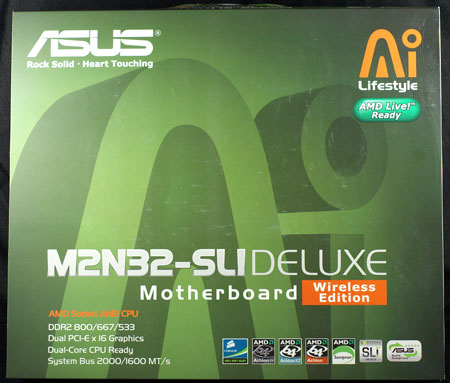
As a top-of the-line 590 board, ASUS builds on the outstanding reputation of the last-generation A8N32-SLI Deluxe. This starts with the box and logos, which are the same family design as the A8N32-SLI Deluxe.
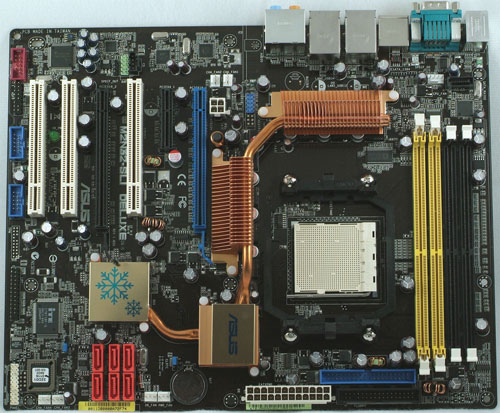 |
| Click to enlarge |
The dual X16 A8N32-SLI Deluxe was the first full 8-phase design we have tested, and ASUS continues the 8-phase design in the M2N32-SLI Deluxe. The layout is generally superb and typically ASUS, with the bulky ATX connector on the right board edge as we prefer. The 4-pin connector is in the less-desired center board location, but the copper heatsinks surrounding the CPU socket do make it a little easier to route the 4-pin cable between the heatsink and rear IO connectors to minimize interference with on-board components.
IDE/floppy connectors are in the ideal right board edge location. You will only find ONE IDE connector, however, so you will have to use SATA or USB peripherals in general. ASUS did provide the standard 6 SATA2 ports supported by 590 plus 2 more SATA2 ports supported by a Silicon Image 3132 connector.
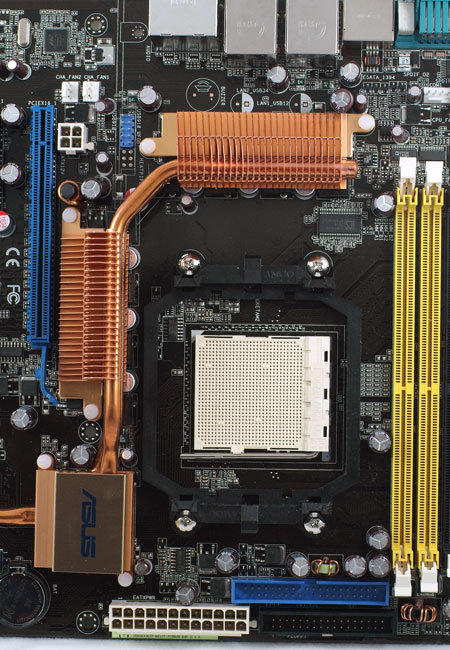
The ASUS 8-phase heatpipe and heatsink cooling system provided effective and completely passive cooling on the M2N32-SLI Deluxe. ASUS has been a proponent of passive board cooling for many years, and ASUS has managed to continue to provide passive solutions even as the chipset cooling requirements have continued to increase.

The rear IO ports combine many useful connectors. You won't find a parallel port, but you will find both optical and coaxial S/PDIF connectors along with 6 programmable mini-jacks for the High Definition sound. There is also an external SATA2 connector, an IEEE1394a Firewire port, PS/2 mouse and keyboard ports, serial port, 2 Gigabit LAN connectors, 4 USB ports, and a connector for the included antenna for the wireless LAN. Whatever you need to connect is more than likely supported on this top-of-the-line ASUS board.
Overclocking
| ASUS M2N32-SLI Deluxe Overclocking Testbed |
|
| Processor: | AM2 4800+ (X2, 2.4GHz, 1MB Cache per core) |
| CPU Voltage: | 1.525V (default 1.4V) |
| Cooling: | AMD Stock Heatpipe FX62 Cooler |
| Power Supply: | OCZ Power Stream 520W |
| Memory: | Corsair Twin2x2048-PC2-8500C5 (2x1GB) (Micron Memory Chips) |
| Hard Drive | Hitachi 250GB 7200RPM SATA2 16MB Cache |
| Maximum OC: (Standard Ratio) |
260x12 (5x HT, 3-3-3-Auto) 3120MHz (+30%) |
| Maximum FSB: (Lower Ratio) |
350 x 9 (4x HT, 3-3-3-Auto) (3042MHz, 2 DIMMs in DC mode) (+75% Bus Overclock) |
ASUS told us in meetings that the M2N32-SLI Deluxe was capable of overclocking to a 350 CPU clock speed. At 1.525V on the CPU we reached a highest stable speed of 350x9. This is a 75% bus overclock and the highest speed we have ever reached in any of the AM2 motherboard tests. The M2N32-SLI Deluxe was extremely stable at this speed, and we may have reached even higher speeds if we had dropped the multiplier further, increased the voltage more, or used better CPU cooling. We stayed at the 9x multiplier for consistency with other test results.
At the stock 12x multiplier the system reached 260x12, 3.12GHz, at the same voltage. This is again the highest this CPU has achieved. The ASUS 8-phase design appears to work very well in maximizing stability in overclocking. The passive cooling system was also very effective even at these high overclocks. Again, you may be able to achieve even better results with some active cooling on the chipsets. The SPP, in particular, seems to get hotter than the new 590 MCP and it may benefit from active cooling.
It was very satisfying to reach a stable 350 MHz with a system with passive cooling. The only active fan on the board was the CPU cooler fan, and even that was a stock AMD cooling fan with a heatpipe.
Memory Testing
Optimum tRAS
DDR2 memory behaves quite differently in ASUS tRAS testing than we have seen on other AM2 boards. As you can see from the standard chart below, a 2GB kit of Corsair 8500 (DDR2-1066) experienced the SAME bandwidth no matter what tRAS setting was used. ASUS is apparently controlling and optimizing tRAS timings internally.
| Memtest86 Bandwidth ASUS M2N32-SLI Deluxe with AM2 4800+ |
|
| 6 tRAS | 3138 |
| 7 tRAS | 3138 |
| 8 tRAS | 3138 |
| 9 tRAS | 3138 |
| 10 tRAS | 3138 |
| 11 tRAS | 3138 |
| 12 tRAS | 3138 |
| 13 tRAS | 3138 |
| 14 tRAS | 3138 |
| 15 tRAS | 3138 |
| 16 tRAS | 3138 |
| 17 tRAS | 3138 |
| 18 tRAS | 3138 |
| AUTO (CPUZ tRAS 18 Reported) |
3248 |
To further test this idea, we also ran tRAS at the AUTO setting, which yielded the highest memory bandwidth in the tRAS tests. To determine the tRAS that was being set by AUTO we looked at memory timings with CPUZ. That utility reported tRAS of 18, which is the highest available setting. We do not really know whether 19 is being set by auto or whether AUTO merely reports the highest setting but then dynamically adjusts tRAS.
Whatever the mechanism, a tRAS setting of AUTO produced the highest memory bandwidth. All stock benchmarking was performed with Corsair 8500 settings of DDR2-800 at 3-3-3-Auto settings at 2.225V.
Memory Stress Testing
The wide range of voltage controls on the ASUS M2N32-SLI Deluxe help users to get the most out of overclocking and the best performance from memory modules. Most DDR2-800 memory is rated at conservative 5-5-5-15 timings, but that's also assuming you only run with the default 1.8 V. We have found in our DDR2 testing that many modules are easily able to run 4-4-4-12 timings at 2.0 V, and the Corsair modules we are testing with (rated at 5-5-5-18 DDR2-1066) are generally able to run with 3-3-3-9 timings with approximately 2.2 V.
| ASUS M2N32-SLI Deluxe DDR2-800 Timings - 2 DIMMs (2/4 slots populated - 1 Dual-Channel Bank) |
|
| Clock Speed: | 200MHz |
| Timing Mode: | 800MHz - Default |
| CAS Latency: | 3 |
| RAS to CAS Delay: | 3 |
| RAS Precharge: | 3 |
| RAS Cycle Time: | Auto (18 Reported) |
| Command Rate: | 1T |
| Voltage: | 2.225V |
With two DIMMs installed, testing was completely stable at 3-3-3-Auto 1T timings at DDR2-800. This is very rare for two reasons. First, AMD does not really support 1T timings with DDR2-800 in the current on-chip memory controller, and Gigabyte is the only other board we have tested that can also operate at 1T timings. All of our utilities report operation is at 1T also.
Several benchmarks were run to compare performance at 1T and 2T timings, but we could not find any real-world performance improvements with the 1T timings compared to 2T. AMD is said to be readying a revision to the AM2 memory controller that will officially support 1T Command Rate. Perhaps that new design with support for 1T will make a more significant improvement in performance.
| ASUS M2N32-SLI Deluxe DDR2-800 Timings - 4 DIMMs (4/4 slots populated - 2 Dual-Channel Banks) |
|
| Clock Speed: | 200MHz |
| Timing Mode: | 800MHz - Default |
| CAS Latency: | 3 |
| RAS to CAS Delay: | 3 |
| RAS Precharge: | 3 |
| RAS Cycle Time: | 10 |
| Command Rate: | 2T |
| Voltage: | 2.225V |
The ASUS M2N32-SLI also exhibited remarkable performance with four 1GB DIMMs. Installing four DIMMs stresses the memory subsystem further, but the ASUS was still stable at the same 3-3-3-Auto timings that worked best with 2 DIMMs. As expected, we did have to drop command rate to 2T but we doubt you can measure that impact on a memory controller designed for 2T operation.
The ASUS is the only AM2 motherboard we have tested so far that was able to run four 1GB DIMMs at 3-3-3 timings. That performance speaks very well for the stability of the ASUS design, since the memory controller in all our motherboard tests is the same initial release AM2 CPU.
Epox MF570SLI: Basic Features & Board Layout
| Epox MF570SLI | |
| CPU Interface | Socket AM2 |
| Chipset | NVIDIA 570 SLI (a single 590 SLI MCP) |
| Bus Speeds | 200 to 450 in 1MHz Increments |
| Memory Speeds | DDR2 at Auto, 400, 533, 667, 800 |
| PCIe Speeds | 100 to 145 in 1MHz Increments |
| Core Voltage | Auto, -0.2V to +0.2V in 0.025V increments (With 1.4V CPU 1.2v to 1.6v) |
| Chipset Voltage | 1.5V, 1.6v, 1.7v, 1.8v |
| CPU Clock Multiplier | Auto, 4x-25x in 1X increments |
| DRAM Voltage | 1.8V to 2.5V in .1v increments |
| HT Voltage | 1.2v, 1.3v, 1.4v, 1.5v |
| 1T/2T Memory | Auto, 1T, 2T |
| Memory Tuning | 33 Options |
| Refresh Row Cycle | Auto, 75ns, 105, 127.5, 195, 327.5 (Separately Adjustable for 4 DIMMs) |
| Refresh Rate | Auto, 7.8ms, 3.9ms |
| Clock Drive Strength | Auto, Increment, Decrement |
| CKE Drive Strength | Auto, Increment, Decrement |
| CS/ODT Drive Strength | Auto, Increment, Decrement |
| AADR/CMD Drive Strength | Auto, Increment, Decrement |
| Data Drive Strength | Auto, Increment, Decrement |
| DQS Drive Strength | Auto, Increment, Decrement |
| HyperTransport Frequency | 1000MHz (1GHz) |
| HyperTransport Multiplier | Auto, 1X to 5X |
| HT Width | 8up/down, 16up/down |
| Spread Spectrum | CPU, PCIe, SATA, HT Individually Adjustable Disabled, Center, Down |
| SSE/SSE2 instructions | Enabled, Disabled |
| Special IO for PCI Card | Enabled, Disabled |
| Smart CPU Fan Control | Full Speed, By Duty Cycle, By Temperature |
| Memory Slots | Four 184-pin DDR2 DIMM Slots Dual-Channel Configuration Regular Unbuffered Memory to 4GB Total |
| Expansion Slots | 2 PCIe X16 2 PCIe X1 3 PCI Slots |
| Onboard SATA/RAID | 6 SATA2 Drives by 590 MCP (RAID 0, 1, 1+0, 5) PLUS 2 SATA2 Drives by JMicron 383 (RAID 0, 1, 0+1, JBOD) |
| Onboard IDE/IDE RAID | One Standard ATA133/100/66 (2 drives) PLUS One IDE (2 drives) by JMicron 383 |
| Onboard USB 2.0/IEEE-1394 | 10 USB 2.0 ports supported by MCP No Firewire |
| Onboard LAN | Dual PCIe Gigabit by Marvel 88E1116 PHYs |
| Onboard Audio | Azalia HD Audio by Realtek ALC883 codec |
| BIOS Revision | Award - May 17, 2006 |
The nForce 570 SLI is targeted by NVIDIA at the mainstream market. As such, it is fair to expect that 570 SLI boards will normally offer fewer features than 590 boards. The distinction is somewhat artificial, since the 570 SLI is a simpler one chip solution, but it supports dual X8/single X16 instead of the dual X16 supported by the 2-chip 590 solution. What we mean by artificial is the fact that you will be hard pressed to find any real evidence in today's market that dual X16 SLI can outperform dual X8 SLI. This distinction may exist in the future, but it is just not a reality with today's top graphics cards.
At this time, Epox is not manufacturing a 590 chipset motherboard, and they are to be congratulated for providing a very wide range of overclocking options and board features for their mainstream MF570SLI. This is a board that should sell very well based on an outstanding feature set, good overclocking options, and the kind of added value Epox often delivers on their recent boards. You even get an LED readout much like high-end DFI and momentary switches for mounting outside a case, just like the Foxconn 590 SLI board.
Overclocking options are exceptionally complete, and were it not for boards like the ASUS M2N32-SLI and the Foxconn 590 we would be singing the praises of the Epox BIOS options. As it is Epox manages to provide a DIMM voltage range of 1.8v to 2.5v, but without the fine adjustments found on the ASUS. About the only missing feature is Firewire, which will matter to some, but can be easily added with a card.
A VERY important addition for many will be the JMicron 383 SATA2 RAID chip. Not only does it add two additional SATA2 ports (total 8), but it also adds a second IDE connector for 2 additional IDE devices. Those who point out that Intel and NVIDIA have made optical drives a nightmare with the forced use of SATA optical drives that generally don't exist will be happy to see a manufacturer that listens to what they want.
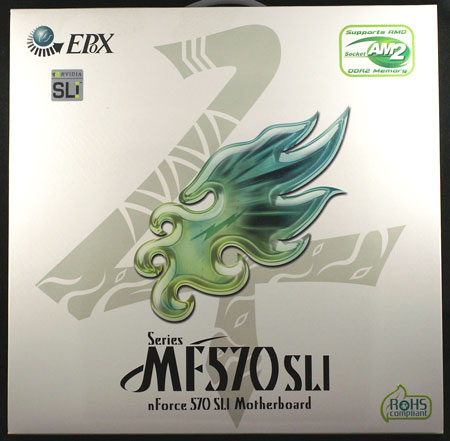
Epox has been using a striking green and off-white oversize package lately, and the MF570SLI continues that new packaging. Not only is the box oversized, but it is crammed with all the round white cables you will need, white SATA2 cables, and a power pack with manuals, disks, heatsinks for a number of small chips, and a temperature measuring cable that attaches to the motherboard.
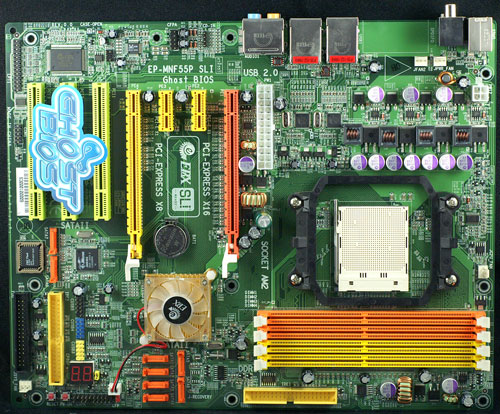 |
| Click to enlarge |
Epox uses a slick 4-phase board design with modular coils that certainly look very attractive compared to the manual wind coils often seen on motherboards. Layout of the green Epox motherboard is an area that generates very mixed feelings, however. The 24-pin ATX connector is smack in the middle of the board. Snaking the bulky power cable is difficult and there is danger of impeding air-flow to the CPU. We understand from discussions with manufacturers that a mid board power connector, near the PCIe slots, makes it easier to manage power to the PCIe slots, but this location is not an easy one for many case designs. The 4-pin 12V connector is better located at the top board edge.
The extra IDE connector is very welcomed, but its location, along with the floppy connector, at the bottom of the board makes it a difficult reach in some case designs. If you're using big video cards you will have trouble routing the second IDE and floppy ribbon. Thankfully the 8 SATA2 ports are thoughtfully located out of the way of video cards - even in an SLI installation.
With two double-width video cards like the 7900GTX, there will still be one usable X1 PCIe and two usable PCI slots. With standard width video cards in SLI mode you pick up a second X1 PCIe and an extra PCI slot. The two PCIe X16 slots are separated by three slot widths, which will make exotic video-cooling workable in most cases.

For a mainstream price you still get both Optical and Coax S/PDIF connectors, dual Gigabit LAN, PS2 keyboard and mouse connector, 4 USB, and six programmable mini-jacks for HD audio. Audio is powered by the Realtek 883 codec. You will not find serial or parallel ports on the rear. If you need Firewire you will have to add it.
While the layout could definitely be improved, once the Epox was installed it was exceptionally stable and trouble-free during out testing. Epox also covers potential BIOS flash problems with their Ghost BIOS feature which allows recovery from most "bad flash" situations.
Overclocking
| Epox MF570SLI Overclocking Testbed |
|
| Processor: | AM2 4800+ (x2, 2.4GHz, 1MB Cache per core) |
| CPU Voltage: | 1.5V (default 1.4V) |
| Cooling: | AMD Stock Heatpipe FX62 Cooler |
| Power Supply: | OCZ Power Stream 520W |
| Memory: | Corsair Twin2x2048-PC2-8500C5 (2x1GB) (Micron Memory Chips) |
| Hard Drive | Hitachi 250GB 7200RPM SATA2 16MB Cache |
| Maximum OC: (Standard Ratio) |
250x12 (5x HT, 3-3-3-13) 3000MHz (+25%) |
| Maximum FSB: (Lower Ratio) |
318 x 9 (4x HT, 3-3-3-13) (2862MHz, 2 DIMMs in DC mode) (+59% Bus Overclock) |
Any board that reaches a 300 clock speed or beyond must be considered an excellent overclocker. The Epox reached 318 clock speed with a 9x multiplier and 250 at the stock 12x multiplier. The 570 is a simpler design than the 590 and it should be as good at overclocking, or better than, the 590. There is no logical reason both 570 boards we have tested top out around 315.
Both platforms use the most up-to-date 590 MCP, with a few items disabled or unimplemented in the 570 version. We are left to wonder if perhaps the maximum overclock of the 570 is being artificially limited so as to make the 590 more attractive? We have no hard evidence of this thought; we are just trying to understand why a simpler solution - which normally overclocks better - does worse with the MSI and EPoX 570 SLI boards.
Memory Stress Testing
Optimum tRAS
The Epox MF570SLI behaved like the Foxconn and ATI in tRAS memory testing. As a result all testing was performed at 3-3-3-13 timings. This provided the greatest bandwidth and the best stability.
Memory Stress Testing
The Epox board does not offer the fine granularity of memory voltage controls that the ASUS board provides, as you can only increase voltage in 0.1V increments. We would prefer at the very least 0.05 V increments, and even better are the 0.025V increments that ASUS, Foxconn and others offer.
| Epox MF570SLI DDR2-800 Timings - 2 DIMMs (2/4 slots populated - 1 Dual-Channel Bank) |
|
| Clock Speed: | 200MHz |
| Timing Mode: | 800MHz - Default |
| CAS Latency: | 3 |
| RAS to CAS Delay: | 3 |
| RAS Precharge: | 3 |
| RAS Cycle Time: | 8 |
| Command Rate: | 2T |
| Voltage: | 2.2V |
With two DIMMs installed, testing was completely stable at 3-3-3-8 2T timings at DDR2-800. Even with further tuning, we were not able to run at 1T command rate at DDR2-800. The highest speed that could run at 1T was DDR2-667. As already stated in the ASUS memory testing, the AM2 does not officially support 2T Command Rate at DDR2-800, so it should come as no surprise that the Epox could not handle the 1T settings. The Gigabyte and ASUS are the only AM2 boards tested thus far that can run at DDR2800 2T, but extensive testing showed no advantage at all in real-world performance using the DDR2-800 1T timings.
| Epox MF570SLI DDR2-800 Timings - 4 DIMMs (4/4 slots populated - 2 Dual-Channel Banks) |
|
| Clock Speed: | 200MHz |
| Timing Mode: | 800MHz - Default |
| CAS Latency: | 3 |
| RAS to CAS Delay: | 4 |
| RAS Precharge: | 3 |
| RAS Cycle Time: | 13 |
| Command Rate: | 2T |
| Voltage: | 2.3V |
Installing four DIMMs stresses the memory subsystem further. We had to drop the timings slightly to a 4 RAS-to-CAS setting at 2.3V to achieve stable performance with 4 DIMMs. In real-world testing this is practically the same as the fastest 3-3-3 timings we achieved on the fast ASUS M2N32-SLI Deluxe.
Test Setup
| Performance Test Configuration | |
| Processor: | AM2 4800+ (X2, 2.4GHz, 1MB Cache per core) |
| RAM: | 2 x 1GB Corsair Twin2x2048-8500C5 Tested at DDR2-800 3-3-3 2.2V to 2.3V |
| Hard Drive(s): | Maxtor MaXLine III 7L300S0 300GB SATA2 (16MB Buffer) Hitachi 250GB SATA2 enabled (16MB Buffer) |
| System Platform Drivers: | NVIDIA - 9.34 ATI - LAN, Audio, SMBus drivers as required |
| Video Cards: | 1 x EVGA 7900GTX - All Standard Tests 2 x EVGA 7900GTX - SLI 1 x ATI X1900XT - ATI Standard Tests (for Reference) 2 x ATI x1900XT (Master + Standard) - CrossFire |
| Video Drivers: | NVIDIA 91.31 ATI Catalyst 6.4 |
| CPU Cooling: | AMD FX62 Heatpipe AM2 Cooler Zalman CNPS9500 AM2 |
| Power Supply: | OCZ PowerStream 520W |
| Motherboards: | ASUS M2N32-SLI Deluxe Epox MF570SLI ATI Crossfire Express AM2 Reference Foxconn C51XEM2AA Gigabyte GA-M59SLI-S5 Biostar TForce 590-SLI MSI K9N SLI Platinum |
| Operating System: | Windows XP Professional SP2 |
Test conditions were maintained the same, as much as possible, over the platforms tested. For better comparison standard test results (1280x1024) were run with a single NVIDIA 7900GTX on all platforms. A single ATI X1900XT was also tested at standard resolutions on the ATI Reference board. Consider this result a sanity check for single card performance and Crossfire. It should not be directly compared to other test results. Since SLI and Crossfire are not yet interchangeable, 1600x1200 4xAA/8xAF SLI was run on the NVIDIA-based boards with a pair of 7900GTX. 1600X1200 4xAA/8xAF Crossfire was run on the ATI using an X1900 XT Master + Single Crossfire. All results are reported in our charts and color-coded for easier identification of results.
AM2 benchmarking used Corsair PC-8500 (DDR2-1066) 2GB kit at 3-3-3 timings at around 2.2V. In recent months the memory market has moved from a 1GB kit to a 2BG kit being the common memory configuration. Our new DDR2 test standard will therefore be 2GB and we used the 2GB DDR memory for best comparison.
General Performance
With the Memory Controller on the Athlon 64 Processor, Winstone benchmarks are no longer very revealing of motherboard performance. With the same CPU (and the same memory controller on that CPU) both Winstones are tightly clustered. The only deviation from that is that boards that are tweaked for best gaming performance are often near the bottom of a tight range of benchmark performance numbers. The Winstone tests themselves are rapidly becoming dated, and are no longer supported by PC Magazine/VeriTest. While Winstones are still useful in providing real world performance data in CPU testing, we have dropped Winstones from our standard motherboard test suite.
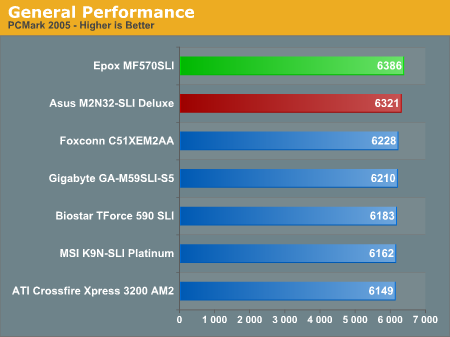
PCMark 2005 results for the seven AM2 boards show the Epox 570 at the top of the performance chart, followed closely by the ASUS M2N32-SLI. These results are very much in line with other results. Despite the close results in these tests, PCMark05 is proving to be a useful overall performance benchmark. It is generally more sensitive than the older Winstones and PCMark04 to recent improvements in PC architecture. PCMark05 results in general relate well to the other performance results we find in our board tests - providing a quick and reliable snapshot of board performance compared to other motherboards.
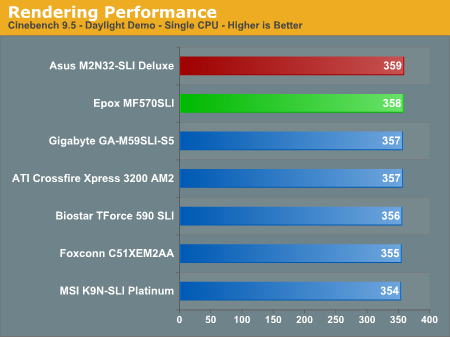
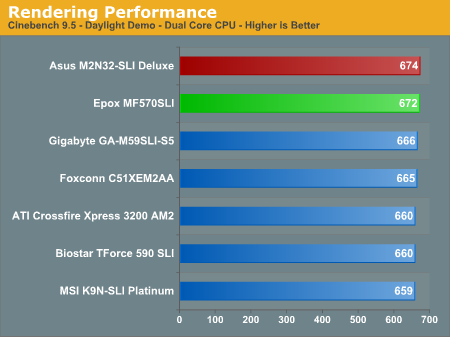
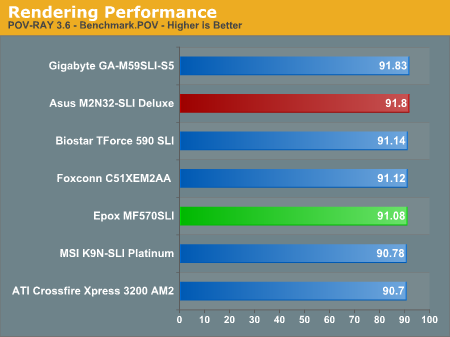
We have replaced Winstones with two benchmarks that use rendering to test system performance. Cinebench 9.5 and POV-RAY 3.6 benchmarks both heavily stress the CPU subsystem while performing graphics modeling and rendering. We utilize the standard benchmark demos in each program along with the default settings. Cinebench 9.5 features two different benchmarks with one test utilizing a single core and the second test showcasing the power of multiple cores in rendering the benchmark image.
While results are generally close in Cinebench, the ASUS 590 tops both Single-Core and Dual-Core test results, followed closely by the Epox in both tests. POV-Ray results are extremely close across DDR2 platforms and show the Gigabyte to be the top performer, followed closely by the ASUS. The Epox performance on POV-Ray 3.6 falls in the middle of the pack.
3D Graphics
The 3DMark benchmarks, published by Futuremark, are probably the most widely quoted gaming performance benchmarks available. While the benchmarks are based on game sequences written by Futuremark to reveal subtle differences in gaming performance, they still have to be considered synthetic benchmarks. They are useful for broad graphics comparisons, but they are no substitute for benchmarks with real gaming engines that are currently being played.
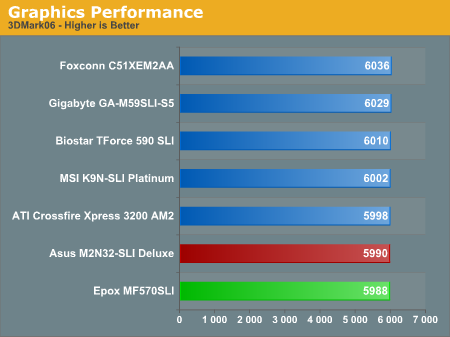

After topping PCMark2005 it was a surprise to see both ASUS and Epox nailing down the bottom of 3DMark performance. Results were close, differences were minor, but neither the ASUS nor Epox stood out from the pack in these benchmarks. 3DMark06 is the newest 3DMark and you can find more in-depth information about this version in the AnandTech article Futuremark's Latest Attempt: 3DMark06 Tested.
Encoding
We have found encoding results are not affected by the graphics card used during the encoding benchmarks, which should come as no surprise since theoretically this is to be expected. This is demonstrated again and again by archive test results for AutoGK using an AMD 4000+ processor with a wide assortment of video cards. The performance range of encoding tests over 2 years with the same CPU is just 48.1 to 49.1 - a difference form high to low of just 1.0 frame per second. Clearly the biggest influence on this encoding benchmark is the CPU used for testing. Because encoding test results vary so little on the same standardized motherboard test platform, they have been dropped from this review and future reviews. Encoding tests are very useful in CPU testing, but they have been shown to be poor motherboard tests - particularly on the AMD platforms with the memory controller on the CPU.
Gaming Performance
We tested with our recently revised group of game tests, which includes Call of Duty 2, Serious Sam 2, Half Life 2: Lost Coast, F.E.A.R, Far Cry, and Splinter Cell: Chaos Theory. All boards were tested with the NVIDIA 7900GTX using NVIDIA 91.27 drivers. The ATI Reference Board was additionally tested with a single ATI X1900XT with Catalyst 6.4 drivers for Reference.
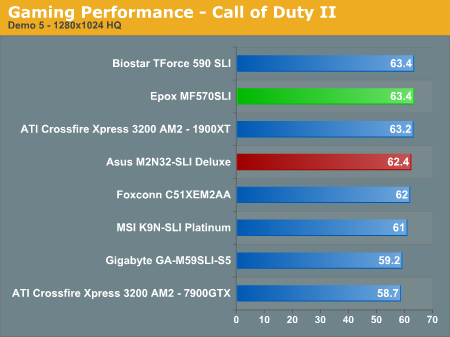
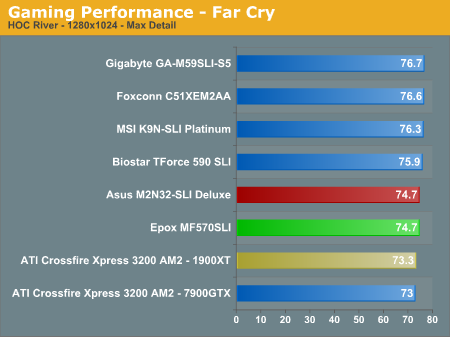
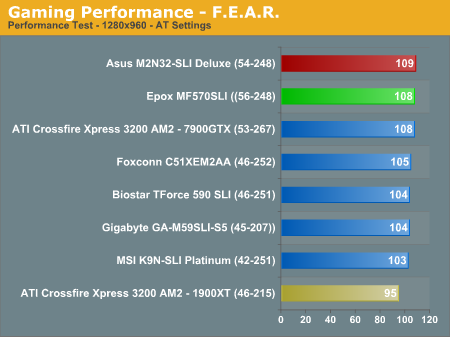
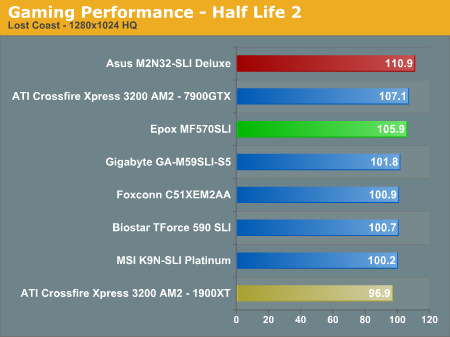

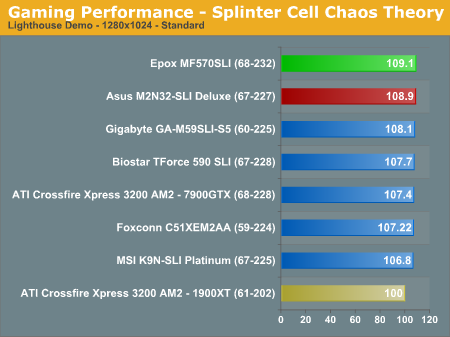
ASUS M2N32-SLI Deluxe results are in red and Epox MF570SLI results are in bright green. It was a bit of a surprise that both these boards finished at or near the top of standard gaming performance. The ASUS generally provided best results among the seven tested boards, followed closely by the Epox MF570SLI.
SLI/CrossFire Gaming Performance
Both major players in the Video Market now have flagship Dual X16 solutions. SLI and CrossFire are about gaming, so dual video tests were confined to gaming benchmarks, and the test suite is heavily slanted to recent and popular titles where SLI and CrossFire make the biggest difference. All dual video testing was at 1600x1200, 4xAA, and 8xAF. Tests were also run with a single X1900XT at this same resolution. The single video high-res results on the ATI AM2 are in Orange and the CrossFire results are in Red.
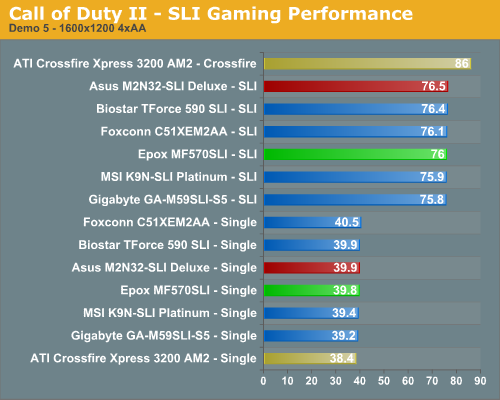
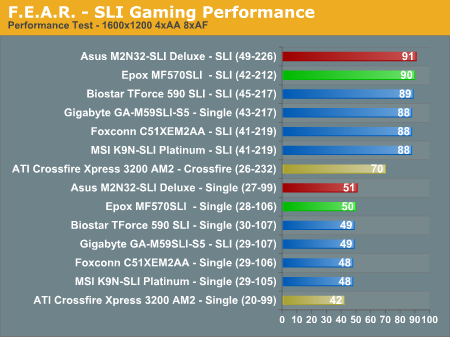
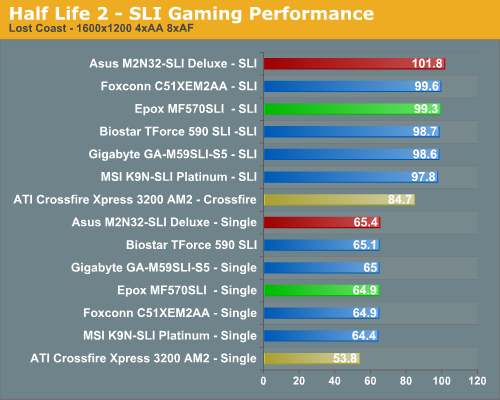
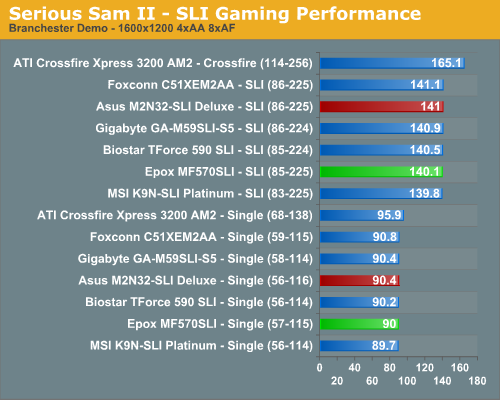
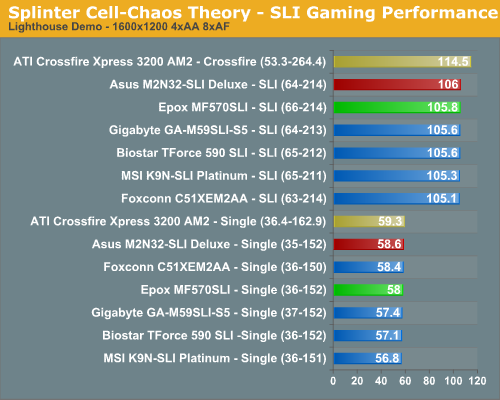
You might think you are looking at results from different video cards in CrossFire/SLI performance. Here leads are larger and positions are often switched from results at standard resolution without the eye candy. ATI CrossFire is the clear winner in Serous Sam2, COD2, and Splinter Cell-Chaos Theory, while NVIDIA SLI owns Half Life 2 and F.E.A.R. Part of these multi-GPU results revolve around which card has optimized drivers available, and ATI just announced Catalyst 6.6 drivers with promised significant performance improvements in F.E.A.R. and HL2. The new 6.6 drivers will be used for testing the retail ATI AM2 motherboards in Part 4 of the AM2 Motherboard Roundup. Among NVIDIA 500 based motherboards, the ASUS and Epox were normally at or near the top of the SLI performance charts.
Overclocking Comparison

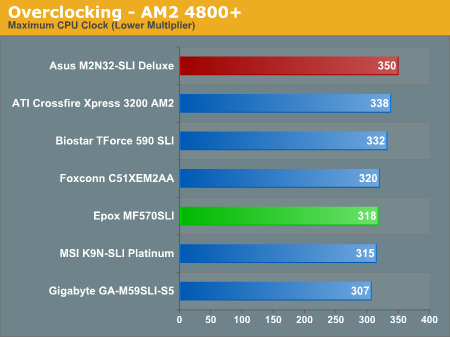
The overclocking capabilities we have measured thus far with the nForce 500 chipsets and ATI RD580 AM2 are nothing short of extraordinary. Here is a new DDR2 memory controller and a refined AMD CPU on new chipsets that consistently reach over 300 clock frequency in overclocking. Both NVIDA and ATI have done a remarkable job in delivering new chipsets with this level of stability and headroom so soon after launch.
The ASUS tops all seven boards in overclocking, easily reaching overclocks we never could achieve in the last generation of 939 AMD processors. 350 at a 9x multiplier is remarkable - all the more so because it only required a 4x HT multiplier. The new 590 chipset makes 1500 HT, a 50% performance increase, an easy target. The same can be said for both platforms with ATI RD580.
The Epox and MSI, both based on the 570 chipset, occupy the bottom of the OC charts. The bottom in this case is still over 300 at a reduced multiplier and 250 at stock 12x. As stated earlier, we suspect 570 SLI may be artificially limited to a highest overclock of about 315 HTT.
Network, USB, Firewire & Disk Controller Performance
Both the ASUS M2N32-SLI Deluxe and the Epox MF570SLI are based on the same IO chip - the new nForce 590 MPP. It is called the nForce 570 in mainstream applications and some super high-end 590 features are not available, but the core IO functions are exactly the same. Since both boards use the already-tested nForce 500 chipsets, we did not repeat Network, USB, or Disk Controller performance.
For more information on the performance of nForce 500 IO, compared to other chipsets, please refer to the comparison graphs in NVIDIA nForce 500: Biostar and MSI Aim for the Gold and the chipset launch review nForce 500: nForce4 on Steroids?
In Part 4 retail ATI RD580 AM2/SB600 motherboard(s) will be reviewed. Network, USB, Firewire & Disk Controller Performance will be compared between the ATI and NVIDIA chipsets and will be reported in that final installment of the AM2 Motherboard Roundup.
Rightmark 2.2
Audio testing used the latest version 2.2 of the Rightmark 3D Sound CPU utilization test. This benchmark measures the overhead or CPU utilization required by a codec or hardware audio chip. Versions earlier than 2.2 would not work properly on the RD580 chipset.

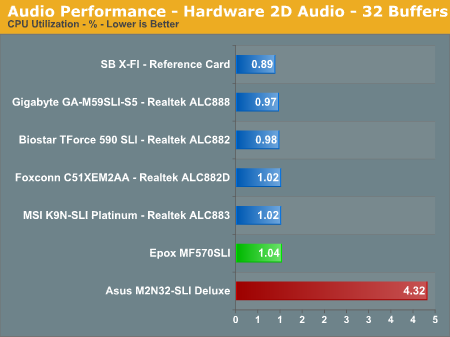

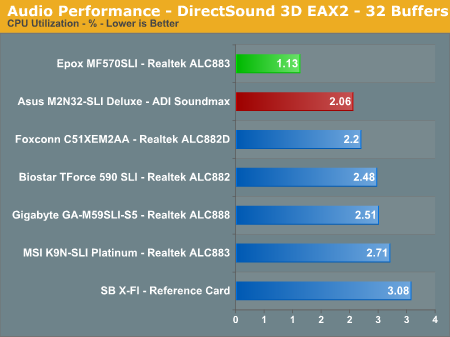
ASUS uses the ADI Soundmax codec, while almost everyone else is using Realtek. The ADI results were the poorest in these tests, but they were still much lower than any of the past generation HD CPU utilization results on single core. ASUS tells us ADI has worked wonders with the performance of their recent drivers - a claim we can easily test in our game FPS tests below.
The Epox codec is the familiar Realtek ALC883. All benchmarks of the Realtek codecs used Realtek Driver Version 1.38. CPU utilization across the board was the lowest we have ever measured with this utility. These utilization numbers are the result of the dual-core CPU as Realtek uses load sharing to drive the audio codec. Unfortunately, as we first described in Intel Core Duo: AOpen i975Xa-YDG to the Rescue, these low test results do not consistently translate into better FPS results in gaming. Results with HD audio on dual-core showed a similar loss of FPS whether run with a single or dual-core CPU.
Game Audio Performance
The ALC-883 is a feature reduced version of the ALC-882 but has nearly the same audio quality and performance in our testing. Our subjective headphone testing revealed a slight difference between the two codecs, with the output from the ALC-882 sounding clearer in the treble and mid-range tones. However, the difference was negligible when utilizing our 4, 5.1, or 7.1 speaker setup in a typical room environment.
The Sound Blaster X-FI has the lowest overall rates with the ALC-882 and the ALC-880 following closely. The ADI has the poorest utilization figures until we get to 3D Audio + EAX. ADI does not currently support EAX and EAX features are turned off in attempts to test that feature on ADI. However, subjective sound quality is quite good with ADI. Sound Quality was also very good while listening to the ADI 1988B through headphones. Let's find out how these results translate into real world numbers.
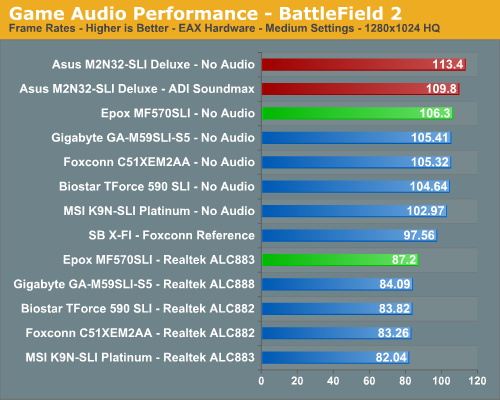

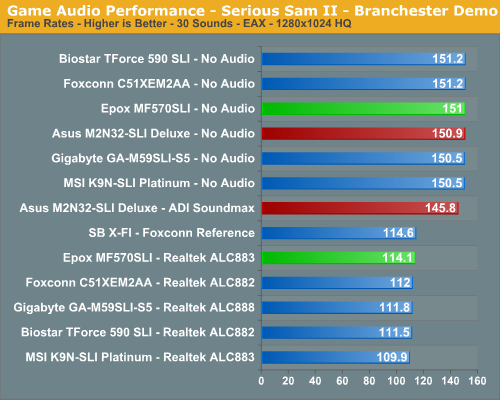

At first glance the performance of the ADI Soundmax on the ASUS M2N32-SLI Deluxe stands out for the extremely small loss of performance in all games. This is particularly true in Battlefield2 and Serious Sam where frame rates only dropped by 3 to 4% compared to the usual 25% to 36% drop with Realtek chips. However, on closer inspection we discovered that the ADI drivers do not currently support EAX. Performance results, therefore, cannot be directly compared to Realtek results, where the Realtek drivers do support EAX.
For now, the ADI Soundmax performance appears promising, but we will reserve conclusions until ADI supports EAX. Nonetheless the actual sound quality of the ADI codec was very pleasing. Just keep in mind that positional EAX does not yet work, and that may be an issue in certain games.
Obviously, if you are a serious gamer, then a dedicated sound card is still useful to ensure consistent frame rate averages across a wide variety of games, and in the case of the Sound Blaster X-Fi, you also get improved audio quality and EAX3/4/5 support. If you'd like more details on the Realtek solutions, you can refer to the Realtek HD Audio Codec Specifications.
Realtek has been very consistent in recent months in releasing regular updates to their HD audio drivers, and we suspect that trend will continue with ATI, Intel, and NVIDIA all now firmly committed to HD Azalia audio. Each new Realtek update has lowered CPU utilization and we also hope that will continue.
Final Words
It is easy to understand why AMD chose the ASUS M2N32-SLI as the Reference Board shipped in their launch kits. The ASUS is a remarkably stable 8-phase motherboard with an innovative and completely passive cooling solution for what is generally a rather hot NVIDIA 590 chipset. The shipping retail version of the board is improved even more - overclocking higher and providing even more features. All of the NVIDIA 590 features are supported and the overclocking options are noteworthy. In particular, ASUS should be applauded for including very fine increments in their voltage adjustments. Most overclockers are finding these finer adjustments very useful for getting the most from their boards by using lower voltage settings, which presents less risk of damage.
The ASUS is well-laid out, easy to install, and very compatible with every peripheral we threw at it. It even comes with the stock two Gigabit LAN ports PLUS a built-in wireless card. Our only slight reservation is the lack of support for EAX in current ADI HD audio drivers. Otherwise the ADI sounds fine and EAX support would make it a great all-around solution. At this point in time you will have a hard time finding a better nForce 590 SLI board than the ASUS, but the Foxconn 590 is also a contender, as is the Gigabyte 590.
The only other drawback for any of these 590 motherboards is the high price you will pay. That is where the Epox MF570SLI shines. At about half the price of the 590 boards the Epox performs almost exactly the same as the top-performing ASUS. It cannot overclock quite as far, if you consider 318 a limitation, and it is missing Firewire, but otherwise the feature sets are remarkably similar. Yes, the Epox only supports single X16/dual X8, and the 590 boards support dual X16, but we have yet to measure any real performance difference in dual X8 versus dual X16 with current video cards. At its price there is certainly a lot to like with the Epox. You also should take a closer look at the MSI 570 tested in this roundup series. Performance is similar to the Epox and price will also likely compete well with the Epox MF570SLI.
It is not quite time for Editors' Choices in our AM2 motherboard roundup as we have a Part 4 coming. The AM2 Roundup series will conclude with reviews of ATI RD580 AM2 motherboards in the coming weeks. Results from the ATI Reference Board are included in our results here and you can find additional information in our review CrossFire Xpress 3200: RD580 for AM2. ATI's chipset is finally starting to appear on retail AM2 motherboards and we have the MSI and ECS retail boards on their way for review. Both feature the new SB600 ATI Southbridge that finally makes an all-ATI chipset solution fully competitive in the marketplace. We will then review all we have learned about motherboards for AM2 and make selections for Editors' Choice Awards.
There is absolutely no doubt that the AM2 platform is clearly the fastest setup you can currently buy, even if it is only a few percent faster than last generation's Socket 939. However, things will change rapidly toward the end of next month when Intel introduces Core 2 Duo (Conroe). Prices will drop across the board and AM2 will be an ever better buy in just a few weeks. There is also the concern that Conroe supply may be constrained for months, which is currently just speculation, but still a real concern.
If you need a system today any of these AM2 boards will meet your needs. The ASUS M2N32-SLI Deluxe and Foxconn stand out at the top, and the Epox is particularly attractive if price is a concern. However, if you can wait a few weeks you will be rewarded with a much better value no matter what system you buy.







